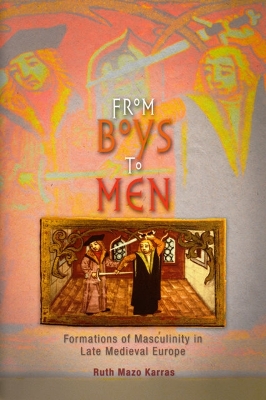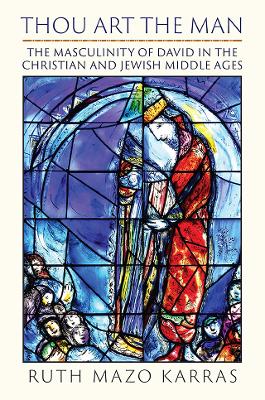The Middle Ages
3 total works
While the social identity of women in medieval society hinged largely on the ritual of marriage, identity for men was derived from belonging to a particular group. Knights, monks, apprentices, guildsmen all underwent a process of initiation into their unique subcultures. As From Boys to Men shows, the process of this socialization reveals a great deal about medieval ideas of what it meant to be a man—as distinguished from a boy, from a woman, and even from a beast.
In an exploration of the creation of adult masculine identities in the fourteenth and fifteenth centuries, From Boys to Men takes a close look at the roles of men through the lens of three distinct institutions: the university, the aristocratic household and court, and the craft workshop. Ruth Mazo Karras demonstrates that, while men in the later Middle Ages were defined as the opposite of women, this was never the only factor in determining their role in society. A knight proved himself against other men by the successful use of violence as well as by successful control of women. University scholars proved themselves against each other through a violence that was metaphorical and against other men by their Latinity and their use of the tools of logic and rationality. Craft workers proved their manhood by achieving independent householder status.
Drawing on sources throughout Northern Europe, including court records and other administrative documents, prescriptive texts such as instructions for dubbing to knighthood, biographies, and imaginative literature, From Boys to Men sheds new light on how young men were trained to take their place in medieval society and the implications of that training for the construction of gender in the Middle Ages.
Rescuing maleness from its classification as an ungendered category, From Boys to Men unravels what it meant to be men in a womanless context, revealing the common threads that emerge from the study of young manhood in various disparate institutional settings.
The Middle Ages are often viewed as a repository of tradition, yet what we think of as traditional marriage was far from the only available alternative to the single state in medieval Europe. Many people lived together in long-term, quasimarital heterosexual relationships, unable to marry if one was in holy orders or if the partners were of different religions. Social norms militated against the marriage of master to slave or between individuals of very different classes, or when the couple was so poor that they could not establish an independent household. Such unions, where the protections that medieval law furnished to wives (and their children) were absent, were fraught with danger for women in particular, but they also provided a degree of flexibility and demonstrate the adaptability of social customs in the face of slowly changing religious doctrine.
Unmarriages draws on a wide range of sources from across Europe and the entire medieval millennium in order to investigate structures and relations that medieval authors and record keepers did not address directly, either in order to minimize them or because they were so common as not to be worth mentioning. Ruth Mazo Karras pays particular attention to the ways women and men experienced forms of opposite-sex union differently and to the implications for power relations between the genders. She treats legal and theological discussions that applied to all of Europe and presents a vivid series of case studies of how unions operated in specific circumstances to illustrate concretely what we can conclude, how far we can speculate, and what we can never know.
"How do we approach the study of masculinity in the past?" Ruth Mazo Karras asks. Medieval documents that have come down to us tell a great deal about the things that men did, but not enough about what they did specifically as men, or what these practices meant to them in terms of masculinity. Yet no less than in our own time, masculinity was a complicated construct in the Middle Ages.
In Thou Art the Man, Karras focuses on one figure, King David, who was important in both Christian and Jewish medieval cultures, to show how he epitomized many and sometimes contradictory aspects of masculine identity. For late medieval Christians, he was one of the Nine Worthies, held up as a model of valor and virtue; for medieval Jews, he was the paradigmatic king, not just a remnant of the past, but part of a living heritage. In both traditions he was warrior, lover, and friend, founder of a dynasty and a sacred poet. But how could an exemplar of virtue also be a murderer and adulterer? How could a physical weakling be a great warrior? How could someone whose claim to the throne was not dynastic be a key symbol of the importance of dynasty? And how could someone who dances with slaves be noble?
Exploring the different configurations of David in biblical and Talmudic commentaries, in Latin, Hebrew, and vernacular literatures across Europe, in liturgy, and in the visual arts, Thou Art the Man offers a rich case study of how ideas and ideals of masculinity could bend to support a variety of purposes within and across medieval cultures.


